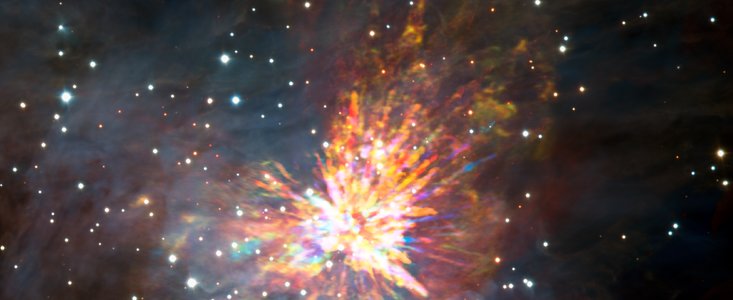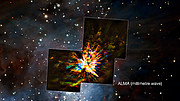Pressmeddelande
Stjärnors fyrverkerier fångades av ALMA
7 april 2017
Stjärnexplosioner förknippas med stjärnors spektakulära död i supernovor, men nya observationer med ALMA ger istället en inblick i explosioner alldeles i början av stjärnors livscykel. Med hjälp av dramatiska bilder har astronomer kunnat studera de fyrverkeriliknande resterna efter födseln av en klunga av massiva stjärnor. Resultaten visar att också stjärnbildning kan vara en våldsam och explosiv process.
I stjärnbilden Orion, 1350 ljusår bort, ligger en tätpackad och aktiv stjärnfabrik som kallas för Orion Molecular Cloud 1 (OMC-1). Den ingår i samma komplex av moln som den berömda Orionnebulosan. Stjärnor föds när ett stort moln av gas, med en massa på mer än hundra gånger så mycket som vår sol, störtar samman under sin egen tyngd. Där gasen blir som allra tätast antänds sedan protostjärnor som börjar att glida slumpmässigt omkring inuti molnet. Med tiden faller en del stjärnor in mot områdets gravitationscentrum, som vanligtvis domineras av en särskilt stor protostjärna. Om stjärnorna har ett nära möte innan de kan fly från sin barnkammare kan det leda till våldsamma interaktioner.
För ungefär 100 000 år sedan började flera protostjärnor bildas djupt inuti OMC-1. Gravitationen började att dra ihop dem allt snabbare fram tills för 500 år sedan då två av dem slutligen kolliderade. Astronomer är inte säkra på om de bara snuddat vid varandra eller om de frontalkrockat. I vilket fall utlöste det ett kraftfullt utbrott som kastade ut närliggande protostjärnor och hundratals kolossala strömmar av gas och stoft ut i den interstellära rymden med hastigheter på mer än 150 kilometer i sekunden. Denna omvälvande stjärndust släppte ut lika mycket energi som solen gör under 10 miljoner år. Nu hela 500 år senare har ett forskarlag som leds av John Bally vid University of Colorado, USA, använt Atacama Large Millimeter/submillimeter Array (ALMA) för att blicka in i hjärtat av detta moln. Där upptäcktes de utkastade resterna från den explosiva födelsen av denna klunga av tunga stjärnor. Mer än något annat liknar dessa fyrverkerier i kosmisk tappning, med serpentinliknande strömmar som skjuter iväg i alla riktningar. Sådana explosioner väntas vara relativt kortlivade, och rester av det slag som ALMA nu sett varar bara några århundraden. Men även om de är flyktiga kan sådana explosioner bland protostjärnor vara relativt vanliga. De skulle också kunna hjälpa till att reglera takten som nya stjärnor bildas genom att förstöra de jättelika molekylmoln där de inblandade stjärnorna fötts. Tecken på den explosiva härkomsten av resterna i OMC-1 upptäcktes först 2009 av antennuppställningen Submillimeter Array på Hawaii. Bally och hans forskarlag har även studerat detta objekt i kortvågigt infrarött ljus med teleskopet Gemini South i Chile. Då kunde de avslöja strömmarnas märkvärdiga struktur, som sträcker sig nästan ett helt ljusår genom rymden. De nya bilderna från ALMA visar i hög upplösning upp explosionens detaljer, i synnerhet hur gas av kolmonoxid (CO) är fördelad inuti strömmarna och hur den rör sig. Detta kommer att hjälpa astronomer att förstå kraften bakom explosionen och vilken inverkan sådana explosioner kan ha där stjärnor bildas i hela vår galax.
Mer information
ESO, Europeiska sydobservatoriet, är Europas främsta samarbetsorgan för astronomisk forskning och världens mest produktiva astronomiska observatorium. Det stöds av 16 länder: Belgien, Brasilien, Danmark, Finland, Frankrike, Italien, Nederländerna, Polen, Portugal, Schweiz, Spanien, Storbritannien, Sverige, Tjeckien, Tyskland och Österrike. ESO:s ambitiösa verksamhet rör design, konstruktion och drift av avancerade markbaserade forskningsanläggningar som gör det möjligt för astronomer att göra banbrytande vetenskapliga upptäckter. ESO spelar dessutom en ledande roll i att främja och organisera samarbeten inom astronomisk forskning. ESO driver tre unika observationsplatser i Chile: La Silla, Paranal och Chajnantor. Vid Paranal finns Very Large Telescope, världens mest avancerade observatorium för synligt ljus, och två kartläggningsteleskop. VISTA arbetar i infrarött ljus och är världens största kartläggningsteleskop och VST (VLT Survey Telescope) är det största teleskopet som konstruerats enbart för att kartlägga himlavalvet i synligt ljus. ESO är en huvudpartner i ALMA, världens hittills största astronomiska projekt. Och på Cerro Armazones, nära Paranal, bygger ESO det europeiska extremt stora 39-metersteleskopet för synligt och infrarött ljus, E-ELT. Det kommer att bli ”världens största öga mot himlen”.
Länkar
-
Forskningsartikeln av Bally m. fl., i tidsskriften Astrophysical Journal
- Bilder på ALMA
Kontakter
Robert Cumming, kontaktperson för ESO:s utåtriktade verksamhet i Sverige
Onsala rymdobservatorium
Onsala, Sverige
Tel: 031 772 5500
Mobil: 070 493 3114
E-post: robert.cumming@chalmers.se
John Bally
University of Colorado, USA
E-post: john.bally@Colorado.EDU
Richard Hook
ESO Public Information Officer
Garching bei München, Germany
Tel: +49 89 3200 6655
Mobil: +49 151 1537 3591
E-post: rhook@eso.org
Om pressmeddelandet
| Pressmeddelande nr: | eso1711sv |
| Namn: | OMC, Orion Molecular Cloud |
| Typ: | Milky Way : Nebula : Type : Star Formation |
| Facility: | Atacama Large Millimeter/submillimeter Array |
| Science data: | 2017ApJ...837...60B |






